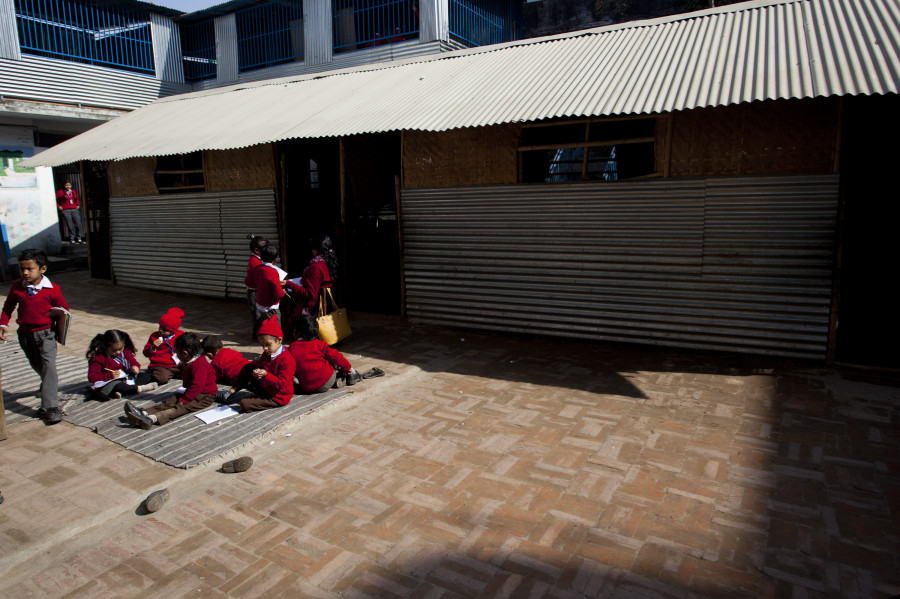As it is
Good teachers make schools resourceful
Shunned by affluent and middle-class families, public schools and marginalised communities are left in ruins.
Mohan Guragain
Actress Karishma Manandhar, popular in the 90s, has been on the news in recent years—not for her feats in the entertainment industry but for her dedication to her studies.
She did not have the chance to complete her education when she was younger and thus, in her 40s, she finally passed her SEE examinations. And to further continue her exploits, she announced that she would join a government high school in Godavari, Lalitpur.
Although I was a passive reader of any information relating to Manandhar, which would pop up on my news feed, her announced enrolment into a government school struck a chord with me.
It is a known fact that public or state-funded schools in Nepal have long been waning. They have deteriorated in quality so much that everyone who can afford to send their children to private schools will ditch them.
But Manandhar’s announcement took me back to my own experience as a public school graduate. When I completed primary school 30 years ago, the nearest secondary school was one-and-a-half hours’ trek uphill. The only private school, at the district headquarters, was equally distant but inaccessible to peasant families like ours, that struggled to educate their children in the first place.
My first school was in the woods—the nearest house was 15 minutes away—with a couple of big playgrounds and several chautaras.
Learning was mostly rote—teachers cared less about explaining ideas and mostly recited lines from textbooks. There was little incentive for children to stay at school after midday, when they had become tired and hungry. In the first grade, I often bunked school along with my nephew, who was also my classmate.
As I climbed grades, I spent more time at school. I started enjoying the little things that were offered to us—hiding under small shrubs and eating limes during tiffin breaks, chasing whatever we had for a ball on the uneven and pebble-lined school grounds. The first five years of school went by in a flash.
Secondary education wasn’t such a cake walk, however. We had to walk for hours every day, to and from school. Ours was one of the biggest schools in all of Tehrathum district, in terms of the number of students. We needed to climb to the bazaar—the town in a cooler place. In the sixth grade, learning became challenging with tougher courses and competition from boys in Myanglung and the nearby Tamphula areas.
But these inconveniences and concerns were swiftly pushed aside when we began our classes—the teachers at the new schools were much better than those at our small village school.
I still remember my English teacher, who would always find innovative ways to teach—especially for students like us who had minimum knowledge of the foreign language. He devised his own techniques for teaching students how to report speech or to change voices. He taught us the basics of English so painstakingly, his teachings stayed with me throughout my further education and career.
But, sadly, this isn’t the case anymore. I haven’t visited my village in the hills for at least five years, but one my friends filled me in—not a single student from one batch passed the school leaving exams.
I was shocked to hear the news. When I was a student there, I was in the hands of competent teachers. But now they have retired.
Public schools have been ruined by politicisation. A year after the restoration of democracy in 1990, all the teachers having served in government-sanctioned posts for at least one year were made permanent employees without testing their quality and determination to teach. The first democratically elected government thereafter appointed its cadres as teachers, many of whom have since become permanent through nominal selection processes.
Since teachers are not transferred mandatorily like civil servants, their schools are close to their homes. Until recently, government teachers were paid only once every four months, meaning they would require other sources of income or incur massive debts. These conditions led them to make politics, business, agriculture or private tuition their parallel occupation. This eroded their devotion to teaching and helping out needy students. Besides, like other government employees, teachers considered themselves as being superior to the common folk, rather than those assigned to serve popular interests. In the absence of rewards or punishment, there has never been a check in such tendencies of teachers in recent years.
Even today, when public schools in general mean poor infrastructure and meagre learning and laboratory materials, my greater emphasis is on qualified teachers. A good teacher always finds ways to connect with students no matter how resource-starved a school may be.
Not all teachers lack passion and zeal, however. But with the mushrooming of private schools and lack of monitoring and regulation in state-funded schools, the majority of students enrolled in public schools are from extremely poor or marginalised communities—their families cannot even afford breakfast before sending their children to school.
So, it is praiseworthy that someone as resourceful as Manandhar chose public school to further her education. But is this enough? Unless bureaucrats, teachers, businesspeople and politicians all send their children to public educational institutions and make an effort to improve them with resources and monitoring, the situation will only deteriorate.




 17.12°C Kathmandu
17.12°C Kathmandu










